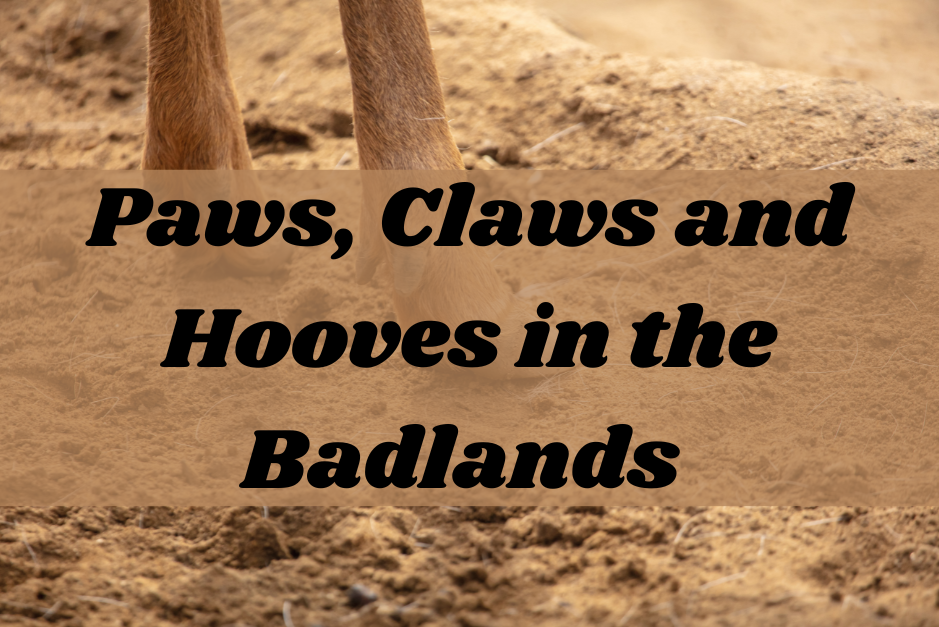Paws, Claws, and Hooves in the Badlands
– By #Wall-Badlands Area Chamber

Welcome to the untamed world of Badlands National Park, where a unique cast of creatures thrives in the face of nature's most formidable challenges. In this rugged expanse of the Great Plains, the residents have mastered the art of survival, defying the relentless grip of harsh winters, scorching summers, and unforgiving terrain. In the vast landscapes of Badlands National Park, the animals have shown incredible toughness, telling stories of how they survive extreme weather and tough conditions. They've come up with smart ways to handle the hot sun, freezing cold, and long periods without rain. From the iconic American Bison, embodying the spirit of the American West, to the elusive Black-footed Ferret, Pronghorns, Big Horn Sheep and much more! The park is full of life, each strand woven with a tale of tenacity.
Bison
Although Badlands National Park falls well within the historical native range of bison, this iconic species faced a severe decline in the late 19th century, making it necessary for their reintroduction. Bison were successfully reintroduced to Badlands in 1963, with the initial population that came from the Theodore Roosevelt National Park. Today, the Badlands bison herd numbers to 1,200. An annual event known as the Badlands Buffalo Roundup takes place each fall. During this event, park rangers work diligently to gather as many bison from the herd as possible into corrals. While in these corrals, rangers collect biological data from each bison and tag recently born calves. Additionally, any sick or injured bison receive necessary medical care during this period. While exploring the Badlands, we strongly recommend you watch for bison, but it's essential to keep in mind that they are untamed creatures. Please maintain a safe distance of at least 100 feet whenever possible and avoid provoking the bison, as they have the potential to cause serious injuries or even fatalities when agitated.
Black-footed Ferret
Between 1996 and 1999, a total of 147 Black-Footed Ferrets were introduced to the Conata Basin region within Badlands National Park. This initial population thrived, and in 2007, 33 ferrets were successfully captured and relocated to their new habitat in Wind Cave National Park, where an additional population of approximately 60 ferrets continues to flourish. However, in 2008, a concerning discovery was made when sylvatic plague, also known as the Black Death when affecting humans, was detected in the Conata Basin area. Sylvatic plague is carried by fleas and poses a significant threat to ferrets, particularly when it infects prairie dogs. Since prairie dogs constitute a significant portion of a ferret's diet, if prairie dogs contract the plague, ferrets are also at risk. To mitigate this danger, research teams undertook efforts to vaccinate some ferrets and applied insecticide to prairie dog burrows to curb the spread of fleas.
Scientists estimate that approximately 120 Black-Footed Ferrets live in Badlands National Park, with around 80 of them residing in the Conata Basin region, as per the Nature Conservancy's assessment. Wildlife biologists continue to conduct annual monitoring and surveillance to safeguard the health of these populations. Notably, Badlands is home to one of the world's few self-sustaining Black-Footed Ferret populations, meaning that the ferrets here are reproducing and capable of maintaining their population without the need for captive breeding programs.
Pronghorn
Pronghorn sightings are most common in the untouched grasslands of the Badlands region. These graceful creatures are often observed in the North Unit, particularly to the north of the Badlands Loop Road (240) and in the expanses of Buffalo Gap National Grassland that border the park. Additionally, visitors have reported sightings both above and below Sheep Mountain Table, a remarkable feature situated along the boundary shared by the North Unit and the South Unit. Keep the eyes peeled for these remarkable animals as you explore the vast and diverse landscapes of the Badlands.
Bighorn Sheep
In 1964, Badlands National Park welcomed its very own bighorn sheep population. A total of twenty-two bighorn sheep were relocated from Pike's Peak in Colorado to the Badlands. Then, in 2004, the park saw the arrival of a second population from Wheeler Peak in New Mexico. Today, the park is proud to provide a home for approximately 250 bighorn sheep, a notable presence among the 80,000-bighorn sheep that exist across the United States. Remarkably, the bighorn sheep in Badlands National Park enjoy a relatively predator-free environment. Unlike many wild bighorn populations in the country, they face minimal to no natural threats from predators. Consequently, the most common causes of bighorn mortality in the park are accidental incidents, often involving lambs misjudging their footing while traversing steep terrain, leading to fatal falls. Disease, particularly pneumonia and hemorrhagic disease, is another significant factor contributing to bighorn sheep fatalities within the park.
Prairie Rattlesnake
Finally, a crucial animal to be aware of when venturing through the Badlands is the Prairie Rattlesnake. Within the Badlands National Park resides a singular species of rattlesnake—the Prairie Rattlesnake. These snakes can grow up to 5 feet, featuring a distinctive triangular head and a body with dark blotches that gradually turn into rings toward the tail. Notably, Prairie Rattlesnakes possess a capability that allows them to detect heat, thanks to specialized heat-sensitive pits located on each side of their head, positioned between the nostrils and eyes. The Prairie Rattlesnake expands the most extensive geographic range among all rattlesnake species in the country. Its habitat spans the vast extensive Great Plains, extending from Canada to Mexico. In South Dakota, it stands as the only venomous snake species. While these reptiles predominantly live in open grasslands and prairies, they may also settle into forested environments.
Last Modified:

